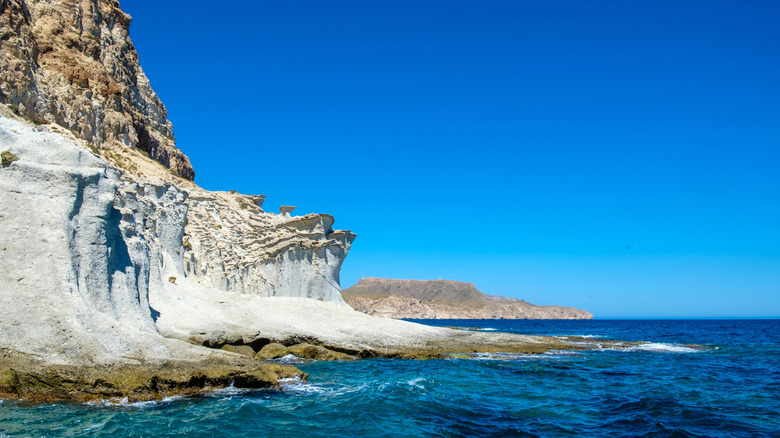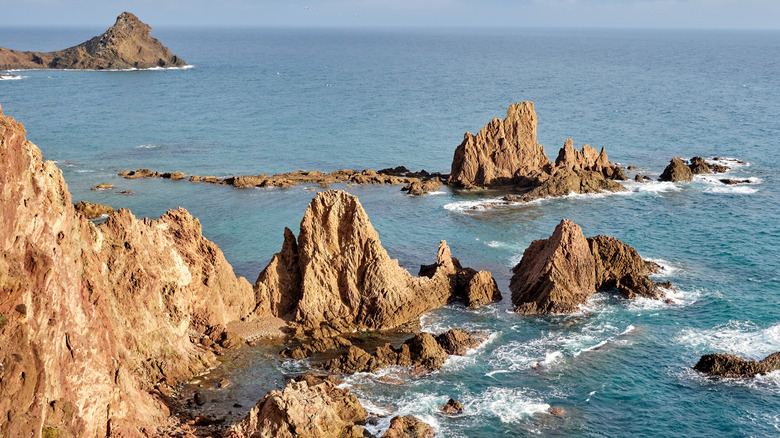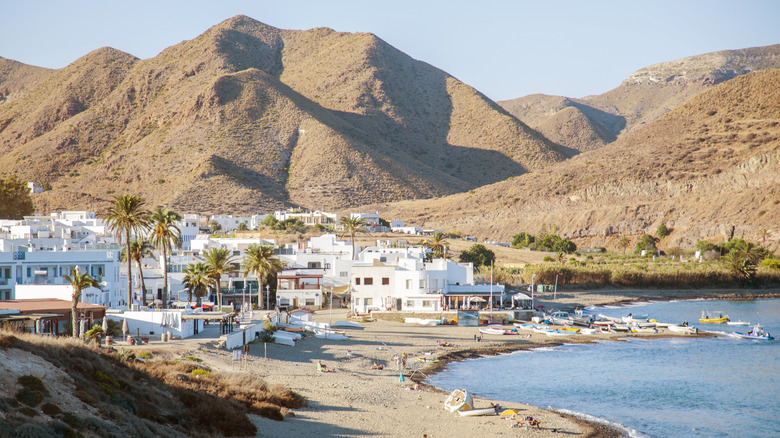Spain's Coast Hides This Underrated Natural Park With Idyllic Beaches And Otherworldly Volcanic Structures
The southern coast of Spain often conjures an image of sunny and sparkling resort towns, but the reality is that many are overcrowded and overpriced. It's always a pleasant surprise to discover a hidden cove full of white sand and crystal blue water, especially one garnished with volcanic sea stacks and fossilized sand dunes. As a UNESCO Global Geopark, the Cabo de Gata-Níjar Natural Park in Andalusia has proof of volcanic activity nearly 16 million years ago, making for a fascinating seascape where you can linger by the beach and engage in active adventure.
Located about 30 miles east of the town of Almería, the park sits in the same neck of the woods as Tabernas, the Badlands of Europe, with desert sandstone canyons and Wild West vibes. Cabo de Gata is the largest protected coastal area in Andalusia, recognized as one of Europe's driest yet most diverse landscapes. With fossilized beaches, alluvial fans, and wetlands dotting the shore where the Sierra de Cabo de Gata plunges into the Alboran Sea, the park feels like it could be on another planet. Full of whitewashed towns untouched by overtourism, a stay here feels like an enchanting escape. It's where Spain's Mediterranean wildness lives on, creating a haven for hikers, beachgoers, and anyone seeking quiet beauty.
Exploring Cabo de Gata-Níjar Natural Park's landscapes
This park's 120,000 acres contain diverse terrain and wildlife, signs of its volcanically turbulent past. Basalt columns, calderas, and fossilized lava flows spread across the landscape, making up a total of 39 notable landmarks. The arrecife de las Sirenas (or Reef of the Mermaids) is an enchanting collection of rock formations off the headland, perfect for kayaking and snorkeling next to a long, sandy beach for sunbathing. El Fraile (The Monk) is the park's highest peak at 1,600 feet, looming over all; the moderately challenging hike to its summit is nearly 4 miles long and takes around two hours. The sun-bleached lava flows cascading into Playazo de Rodalquilar and a medieval fortress built to protect the land from pirate raids present a stunning backdrop to your beach day.
Unusual for Europe, Cabo de Gata has a semi-arid climate, supporting the growth of plants normally only seen overseas. Palm trees, agaves, and prickly pear cactus thrive, making you feel like you're in Cabo San Lucas, Mexico. Over 1,000 documented species of flora uniquely grow here, and the underwater forests of the Salinas salt flats at the southwestern edge of the park are home to a number of migratory birds, the most colorful of which include pink flamingoes and western yellow wagtails.
Aside from a handful of small towns, the park has mostly been left undeveloped and wild, a rarity on the Mediterranean coastline. The best way to take in all this quiet, open nature is by hiking or biking through it. Several tour companies like Celtic Trails, Wild Rover Travel, and the Natural Adventure offer self-guided itineraries leading down Cabo de Gata's entire coastline, from the picturesque Agua Amarga to the fishing village of San José.
Cabo de Gata's best beaches and how to get around the area
Spain boasts more sparkling clean Blue Flag beaches than any other country in the world, and Cabo de Gata's serene, pristine waters are a must-see. Playa de los Genoveses, just around a 2-mile walk from San José, has restricted car access to keep its golden sand and iconic horseshoe bay protected from the masses. With its towering dune and eroded lava stacks, Playa de Mónsul is often recognized for its appearance in "Indiana Jones and the Last Crusade." For an even more remote paradise, Cala de Enmedio is only reachable on foot, by off-road vehicle, or by boat, boasting striking white fossilized sand dunes and turquoise waters.
In general, lest you head in with a tour group, you'll be best getting around Cabo de Gata by car, as public transport is minimal. But since Spain is the absolute best country in Europe for road tripping, you're in luck. You can include the park in a classic road trip through Andalusia since it's only a two-hour drive southeast of Granada. Alternatively, you could fly into Almería from Madrid and book a car upon arrival. Just note that many areas of the park are closed to vehicles in summer to keep tourists at bay — locals prefer to get around by hiking and biking, and you should, too. As an active-vacationer's delight, the lack of cars only adds to the feeling that you're on another planet.
That said, choose your accommodation wisely, based on where and what you're most interested in. Central San José has the most services and best access for beach hopping. Rodalquilar, a historic mining town, feels like a desert oasis, while Agua Amarga has several stylish hotels and B&Bs, along with excellent seafood courtesy of the local fishermen.


